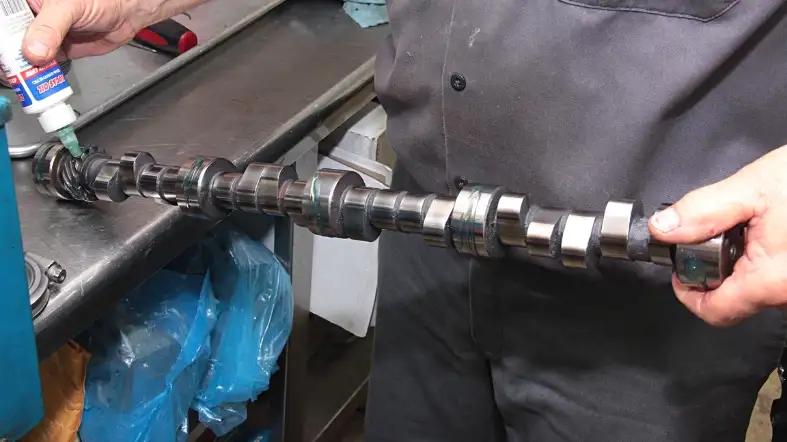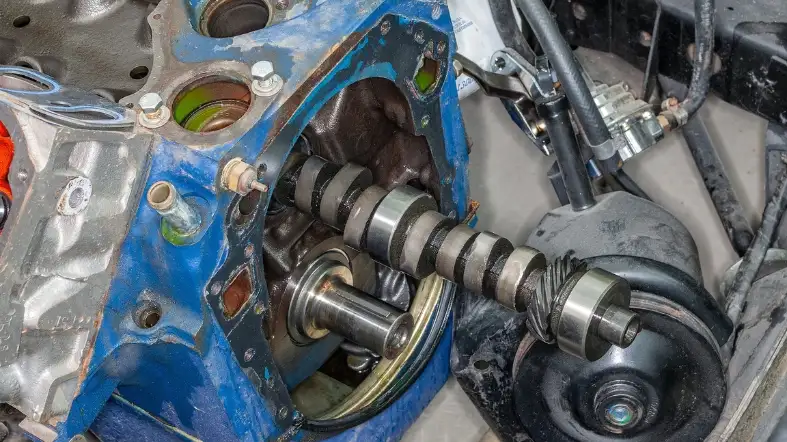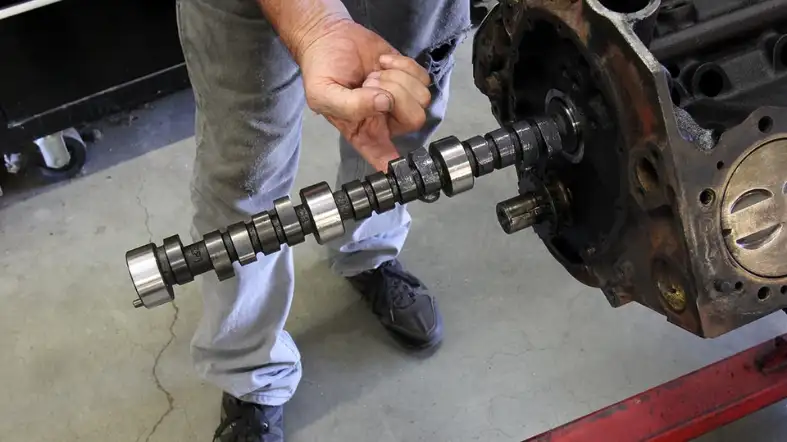If you’re a car enthusiast or mechanic, you know that the camshaft is one of the most crucial components of an engine.
One type of camshaft that has been used for decades is the flat tappet cam. But how can you tell if your engine has a flat tappet cam or a different type?
In this blog post, we’ll explain what a flat tappet cam is and give you tips on how to identify it.

Top 9 ways to Determine if Your Engine Has a Flat Tappet Cam
Here’s how to determine if you have a flat tappet cam in your engine.
Look at the Camshaft
The easiest way to tell if you have a flat tappet cam is to look at the camshaft.
Flat tappet cams have a flat surface on the bottom of the lobe, while roller cams have a rounded surface.
You can see this difference by looking at the end of the camshaft.
Check the Lifters
If you cannot see the camshaft, you can check the lifters. Flat tappet lifters are flat on the bottom and have a slight concave shape on the top.
Roller lifters, on the other hand, have a rounded bottom and a flat top.
Check the Engine’s Service Manual
The first and most reliable way to determine if your engine has a flat tappet cam is to check the engine’s service manual.
The service manual will provide detailed information about the engine, including the type of camshaft used.
If you don’t have the service manual, you can usually find it online or purchase it from an auto parts store.
Look for Stamped Numbers
Another way to determine if your engine has a flat tappet cam is to look for stamped numbers on the camshaft.
Many camshafts have identifying numbers or markings that can tell you if it is a flat tappet cam or not.
However, not all camshafts have markings, and some markings may be difficult to read or interpret.
Measure the Diameter of the Lifters
Flat tappet cams typically use lifters with a smaller diameter than roller cams.
You can measure the diameter of the lifters to determine if your engine has a flat tappet cam.
Use a micrometer to measure the lifter diameter, and compare it to the specifications for your engine.
Look for a Flat Surface on the Bottom of the Lifter
Flat tappet lifters have a flat surface on the bottom, while roller lifters have a rounded bottom.
You can remove one of the lifters and inspect the bottom to determine if it is flat or rounded.
Check the Rocker Arm Ratio
Flat tappet cams typically have a lower rocker arm ratio than roller cams.
You can check the rocker arm ratio by measuring the length of the rocker arm and the distance between the pivot point and the valve stem.
Divide the length of the rocker arm by the distance between the pivot point and the valve stem to get the rocker arm ratio.
Check the Valve Lash
Valve lash is the clearance between the rocker arm and the valve stem. Flat tappet cams typically require more valve lash than roller cams.
You can check the valve lash by removing the valve covers and using a feeler gauge to measure the clearance between the rocker arm and the valve stem.
Look for Wear on the Camshaft
Flat tappet cams are more prone to wear than roller cams.
You can inspect the camshaft for signs of wear, such as pitting or discoloration. If the camshaft shows signs of wear, it may be a flat tappet cam.
How to Visually Check Flat Tappet Cam?

Here is guideline to check visually flat tappet cam:
Step 1: Clean the Camshaft
The first step in visual inspection of a flat tappet camshaft is to clean it thoroughly.
Any debris, dirt, or oil on the camshaft can obscure its surface, making it difficult to identify any potential issues.
Use a soft cloth or a wire brush to remove any contaminants from the camshaft’s surface.
Step 2: Look for Signs of Wear
Inspect the camshaft carefully, looking for any signs of wear, such as pitting or discoloration.
Pitting occurs when the surface of the camshaft is eroded due to contact with the flat tappets.
Discoloration can indicate overheating, which can cause the camshaft to warp or become misshapen.
Step 3: Check for Damage
Look for any visible signs of damage to the camshaft, such as cracks, chips, or nicks.
Any damage to the camshaft can affect the engine’s performance and lead to premature failure.
Step 4: Check Camshaft Lobes
The camshaft lobes are the raised surfaces on the camshaft that push the valves open.
Inspect the lobes carefully, looking for any signs of wear, damage, or irregularities.
Any issues with the camshaft lobes can affect the valve timing, which can lead to poor engine performance.
Step 5: Check Flat Tappets
Inspect the flat tappets carefully, looking for any signs of wear, damage, or irregularities.
Any issues with the flat tappets can affect the camshaft’s performance and lead to premature failure.
What are the Signs of Flat Tappet Camshaft

Here are the signs of flat tappet camshaft failure and how to identify them.
Excessive Engine Noise
One of the most common signs of flat tappet camshaft failure is excessive engine noise.
This noise is typically heard as a tapping or ticking sound, and it can get louder as the engine speed increases.
This noise is caused by the flat tappet lifters failing to properly follow the camshaft lobes, which can lead to metal-on-metal contact and excessive wear.
Poor Engine Performance
Another sign of flat tappet camshaft failure is poor engine performance. This can include reduced power output, rough idling, and poor fuel economy.
This is because the flat tappet camshaft is responsible for regulating the flow of air and fuel into the engine, and if it fails, it can disrupt this process and cause a decrease in engine performance.
Metal Shavings in Oil
If you notice metal shavings in your engine oil, it could be a sign of flat tappet camshaft failure.
This is because the metal-on-metal contact caused by the failing lifters can result in tiny metal shavings that can be carried throughout the engine by the oil.
These shavings can cause damage to other engine components and lead to further engine problems if not addressed.
Low Oil Pressure
Flat tappet camshaft failure can also cause low oil pressure in your engine.
This is because the failing lifters can create excess friction, which can cause a decrease in oil pressure.
Low oil pressure can lead to engine damage and failure, so it is important to address this issue promptly.
Engine Misfires
Finally, engine misfires can also be a sign of flat tappet camshaft failure.
This is because the failing lifters can cause the valves to not open and close properly, which can disrupt the combustion process and lead to misfires.
Engine misfires can cause further engine damage if not addressed promptly, so it is important to have this issue diagnosed and repaired as soon as possible.
FAQs
What Is A Flat Tappet Cam, And How Does It Differ From A Roller Cam?
A flat tappet cam has a flat lifter that rides directly on the camshaft, while a roller cam uses a roller-bearing lifter.
Flat tappet cams were commonly used in older engines, while roller cams are more commonly used in modern engines.
How Can I Tell If My Engine Has A Flat Tappet Cam?
One way to tell is by inspecting the lifter. If it has a flat bottom, it is likely a flat tappet lifter.
Another way is to look up the engine specs to see if it came with a flat tappet cam from the factory.
Why Is It Important To Know If My Engine Has A Flat Tappet Cam?
Flat tappet cams require a specific type of oil with enough zinc and phosphorus additives to prevent premature wear.
Failure to use the correct oil can cause excessive wear on the camshaft and lifters, leading to engine failure.
What Happens If I Use The Wrong Oil In An Engine With A Flat Tappet Cam?
Using the wrong oil in an engine with a flat tappet cam can cause excessive wear on the camshaft and lifters, leading to engine failure.
Symptoms of this type of failure may include ticking or knocking noises from the engine, reduced power, and poor fuel economy.
Can I Convert My Engine From A Flat Tappet Cam To A Roller Cam?
Yes, it is possible to convert an engine from a flat tappet cam to a roller cam, but it can be expensive and may require other modifications to the engine.
How Can I Protect My Flat Tappet Cam?
To protect your flat tappet cam, it is important to use an oil that is specifically designed for use with flat tappet cams.
This type of oil contains enough zinc and phosphorus additives to prevent premature wear on the camshaft and lifters.
How Often Should I Change The Oil In An Engine With A Flat Tappet Cam?
It is recommended to change the oil in an engine with a flat tappet cam every 3,000 miles or every three months, whichever comes first.
This will help ensure that the oil is fresh and contains the necessary additives to protect the camshaft and lifters.
Conclusion
A flat tappet cam is a crucial component in your engine, and it’s important to ensure it’s in good condition.
If you notice any signs of a flat tappet cam failure, such as ticking or knocking sounds, low oil pressure, or poor engine performance, it’s time to take action.
Get your engine checked by a professional mechanic, and if necessary, replace your flat tappet cam with a quality product.
Remember, regular maintenance and inspections are essential for keeping your engine running smoothly and ensuring a long, reliable life for your vehicle.
So keep an ear out for any unusual sounds, keep an eye on your oil pressure, and don’t hesitate to seek professional help if you suspect a problem with your flat tappet cam.
